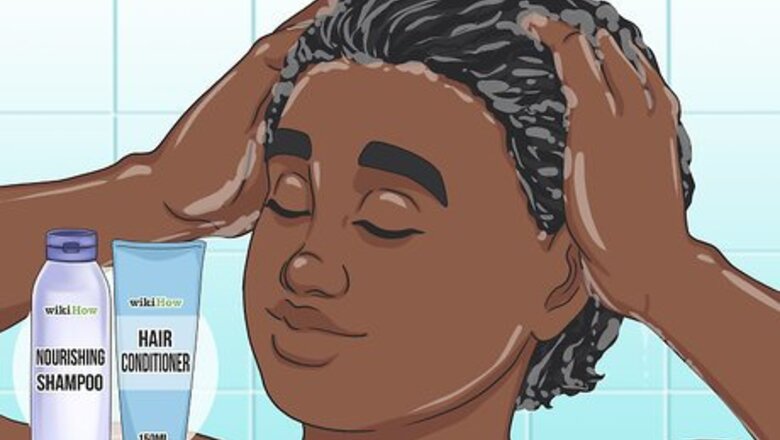
views
Using a Flat Iron to Straighten Your Hair

Shampoo and condition your hair before straightening it. Use your regular shampoo and conditioner to wash your hair before straightening it with a flat iron. This will help protect your hair from heat damage by helping it to retain important nutrients. Clean hair also straightens more easily.
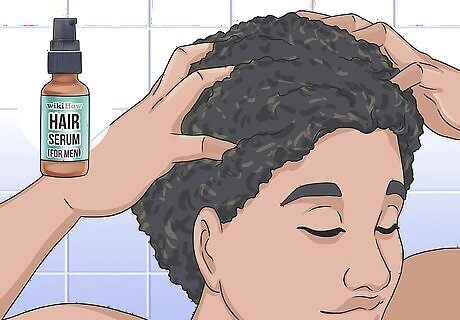
Apply a smoothing balm or serum to your hair. Smoothing balms and serums will make your hair easier to straighten. Apply the balm or serum evenly to your hair with your hands, moving from the crown of your head outwards. If you live in a more humid climate, look for a smoothing serum or balm that specifically says that it is humidity-resistant in order to avoid frizzy hair. Avoid using hair oils before straightening your hair with a flat iron. Hair oils will keep your hair from having volume and bounce.

Coat your hair with heat protectant spray after it has dried. Wait until your hair has dried from the smoothing balm or serum you applied, then spray it evenly with heat protectant spray from the crown of your head outwards. This will help protect your hair from some of the damage that can be caused by flat irons.

Flat iron your hair in sections after it has dried again. After your hair has dried from the heat protectant spray, straighten your hair in small sections with your flat iron. Move from the crown of your head outwards in slow, smooth motions. For particularly curly hair, run a fine-toothed comb through your hair immediately in front of your flat iron. If your hair is curlier in some areas than others, adjust the temperature of your flat iron accordingly. Curlier sections might need more heat, but smoother ones won’t.
Using a No-Lye Relaxer to Straighten Your Hair
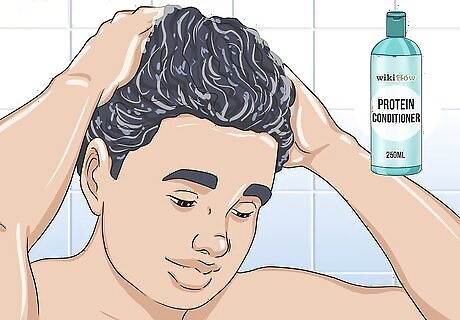
Wash your hair with a protein conditioner 1 week before relaxing it. Use a protein conditioner rather than your normal one a week before you straighten. This will help your hair retain the nutrients it needs to avoid damage during the relaxation process. Do not wash your hair for the week between conditioning and relaxing it. Washing your hair can strip it of important nutrients that will help your hair stay healthy and strong during and after relaxation.
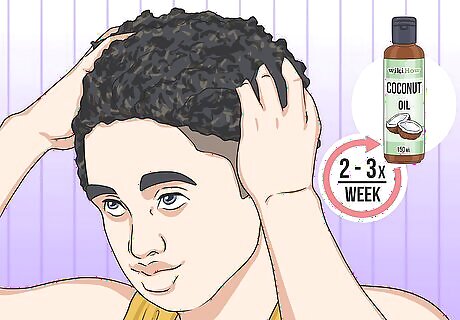
Moisturize and seal your hair with oil or butter 2-3 times in the week before relaxing. Use your fingers to rub the hair oil or hair butter of your choice in your scalp and hair. This will help to protect both your hair and scalp from the chemicals in the relaxer. Hair oils and butter come in a large number of varieties including olive oil, coconut oil, castor oil, almond oil, jojoba oil, and shea butter. Avoid scratching or irritating your scalp in the week before relaxation. Scratches and irritation can weaken the skin on your scalp and the harsh chemicals in relaxers could burn you.
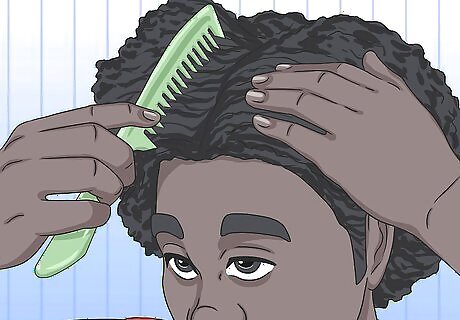
Prepare your hair by parting it, detangling it, and protecting your scalp. Separate your hair into at least 4 sections with hair ties or clips as close to your scalp as possible. Doing this will allow you to detangle your hair, apply relaxer, and rinse and wash your hair more easily. If you have a lot of hair, it might be a good idea to consider separating it into more than 4 sections. Use your fingers to detangle the hair in each section. Gently use your fingers to untangle any knots in your hair. The relaxation process and washing your hair afterwards will only make knots worse. If your fingers can’t detangle a knot, use a wide-toothed comb. Rub petroleum jelly into your scalp and hairline and onto your ears to protect them from the relaxer. Use your fingers to rub petroleum jelly onto the scalp under your hair, around the edge of your hair at your hairline, and on the tops of your ears.
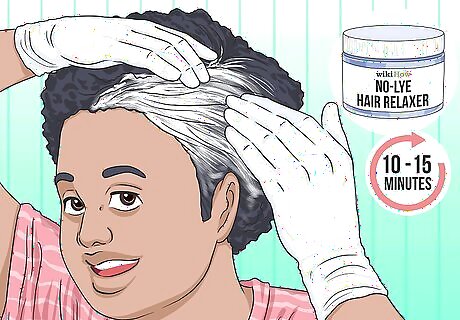
Apply a no-lye relaxer from the crown of your head outwards. Wearing latex gloves, smooth the relaxer onto your hair from the crown outwards. If you don’t smooth the relaxer, it won’t apply evenly to all parts of your hair. Keep the relaxer in your hair for 10-15 minutes. A 10-15 minute period is generally sufficient to allow the chemicals in the relaxer to take effect. Remember to set a timer so that you have a more exact sense of the duration. Leaving the relaxer in longer than recommended can cause hair and scalp damage. Some relaxers may recommend a different period of time. Always be sure to consult the instructions that came with your relaxer to make sure.

Rinse, wash, condition, and moisturize your hair.. Rinse your hair out as thoroughly as possible for several minutes before washing it. Rinsing your hair will give your neutralizing shampoo less chemicals to wash out of your hair. Use a neutralizing shampoo 3-4 times after rinsing. Rub neutralizing shampoo into your hair and rinse it out at least 3 to 4 times before applying your protein conditioner. On the second or third time, leave the shampoo in for at least 5 minutes to allow it to reach your roots. Neutralizing shampoos help to counteract the effect of the high amount of acids in relaxers. Use a protein conditioner after shampooing. Rub the protein conditioner into your hair and scalp with your fingers and leave in for several minutes before rinsing. Follow up your protein conditioner with a leave-in moisturizing conditioner. Use your fingers to rub a leave-in moisturizing conditioner into your hair and scalp after rinsing out the protein conditioner. Avoid moisturizing conditioners that list synthetic oils like petrolatum, mineral oil, or lanolin oil as the main ingredient. Good moisturizing conditions will list water as their first ingredient.

Avoid braiding your hair for 2 weeks after relaxation. Braiding your hair after relaxation can cause damage and breakage by putting tension on hair already weakened by the relaxation process. Give your hair at least 2 weeks to regenerate some of the nutrients it has lost before braiding it.

Reapply relaxer to new growth every 8 weeks. Reapply relaxer to the new growth in your hair every 8 weeks. Only apply the relaxer to the first inch or so of your hair closest to the crown of your head. Applying relaxer to already relaxed hair can cause damage and breakage.
Maintaining Straightened Hair

Use a chelating shampoo every day to remove mineral buildup in your hair. Chelating shampoo binds to minerals in your water and prevents them from building up on your hair and scalp. Rub it into your hair with your fingers to ensure that your hair stays silky and smooth. Chelating shampoo may not be necessary if you have soft water (water with low quantities of calcium and magnesium).

Moisturize and seal your hair on a daily basis and condition once a week. Use moisturizing shampoo and hair oil or butter every day to keep your hair from losing nutrients. Every week, deep condition your hair. When deep conditioning your hair, rub your protein conditioner into your hair and scalp and leaving it in for at least 5 minutes before rinsing.

Wrap your hair every night and comb it every morning. Wrap your hair in a satin or silk do-rag every night to protect it from getting tangled. In the morning, remove any minor tangles in order to keep your hair silky and smooth. Use a wide-toothed comb to avoid causing damage or breakage to your hair.
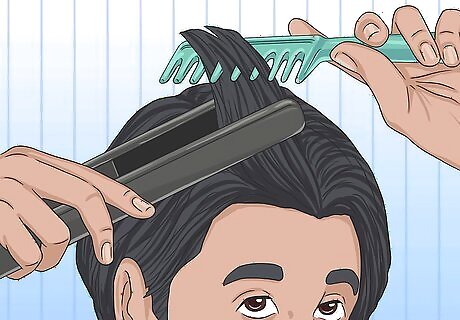
Use a flat iron to straighten any hair that begins to re-curl. Regularly touch up parts of your hair that begin to curl. Apply smoothing balm or serum, then heat protectant spray, and use the flat iron to straighten only the section of your hair that is beginning to curl. Make sure your hair is dry before straightening with a flat iron to avoid frizziness.




















Comments
0 comment